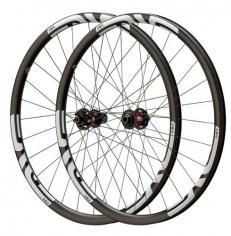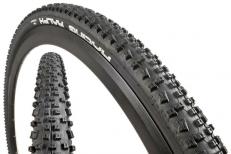Wielen
 Wheels are quite obvious, quite essential and seemingly straightforward components of each bike. Components that need to be able to transfer all that energy as efficiently as possible to the trail. Normally when you buy a bike the wheels and tires are outfitted which the brand thinks fit with your bike the best. But you can upgrade, and change your wheels & tires to suit the terrain you ride on predominantly. And the kind of riding you do.
Wheels are quite obvious, quite essential and seemingly straightforward components of each bike. Components that need to be able to transfer all that energy as efficiently as possible to the trail. Normally when you buy a bike the wheels and tires are outfitted which the brand thinks fit with your bike the best. But you can upgrade, and change your wheels & tires to suit the terrain you ride on predominantly. And the kind of riding you do.
Image: Enve Twenty9 AM tubeless rims
First question, do you choose a 27,5-inch, 29,-inch, 29+, do you ride a fat bike? To determine this you can ask yourself:
- What kind of experience do you I have, am I a beginner, experienced or advanced?
- Am I a technical rider?
- Do I ride XC, enduro or downhill?
- Hoe deep are my pockets?
27-inch vs 29-inch
Nowadays the main wheel sizes you will be choosing between are 27-inch and 29-inch wheels. The different considerations are quite simple:
- A bike outfitted with 27-inch wheels will generally be more agile and easier to thread around twisty technical trails that a 29-er.
- The larger 29-inch wheel will maintain speed more easily, roll over roots and rocks more easily. Also climbing will be more efficient with a 29-er.
- Because of the larger tires there is a bit more dampening in 29-inch tires than 27-inch.
- XC and marathon work: choose a 29-er
- Technical enduro stuff and downhill riding: choose 27-inch bike.
Carbon vs Alloy
As with bike frames, mountainbike sheet sets, and by this we mean the combination of rims and spokes, are available in carbon and alloy. Carbon is lighter and stiffer than alloy, but also a lot more expensive. Stiffness helps in the way the energy is delivered ver directly. That means a carbon wheel will generally ride with more precision and feel smoother in handling.
Tires
 In mountain biking, the choice of tires plays an essential role. The tires should be tuned to the terrain you are riding on for maximum performance.
In mountain biking, the choice of tires plays an essential role. The tires should be tuned to the terrain you are riding on for maximum performance.
Image: Schwalbe Racing Ralph Snakeskin tires
The choice of tires not only affects performance but is important for how comfortable the bike feels. Depending on the weather, the surface and the type of rider, a suitable tire choice can be made for everyone. In every circumstance, a good tire needs to do three things: deliver grip, roll easily and provide a bit of dampening.
Subjects:
- Rolling resistance
- Tire pressure
- Tire width
- Tubeless wheels
- Montage
Rolling resistance
The rolling resistance of a mountain bike tire depends on a number of factors, such as air pressure in the tire, the profile of the studs, the material, rubber compound and structure of the tire and the terrain on which you are riding. The bigger the rolling resistance, the more power a mountain biker will need to deliver. Rolling resistance is influenced by the tread on the tire, where more pronounced or aggressive profiles in some circumstances give too much resistance. Running the correct tire pressure is also essential for good rolling resistance, but also influence grip. There a few observations we can make:
Grip
There a few observations we can make:
- If the tire pressure is too high, the tire will jump around on roots, rocks and other rough stuff on the trails too much. This negatively influences grip. You will want the tire to be in contact with the ground as much as possible.
- The profile needs to vary and match the terrain you ride on: sandy or earthy flowy trails won’t need that much tread. Too much tread will have you digging into the softer trail surface too much, slowing you down and sometimes even making you dig into the soil on corners. However, if you are riding fast flat corners you’ll need a bit more tread on the edges of your tires.
- Rocky terrain asks for more tread and lower tire pressure.
- A wider tire will give you more stability, grip, and power to ride over roots & rocks. But it will deliver more rolling resistance.
- You steer with your front wheel: that means this wheel will generally require a bit more tread than the back wheel. You need all the traction and grip you can get while cornering.
- The back wheel needs to deliver the power, so that tread will generally be a bit more forward facing.
Ideal tire pressure
The ideal tire pressure depends primarily on the weight of the rider and the bicycle. A heavy rider will have to pump his tires more than a light rider. In addition, the terrain plays an important role, with a soft surface, a lower tire pressure will be required. With the usual mountain bike tires, a pressure of 2.0 to 4.0 bar is used. An advantage of tubeless tires is that a lower tire pressure can be used, from 1.5 to 2.5 bar.
Tire width
A wider tire will also run easier than a narrow tire. However, this also applies to rolling resistance at higher speeds. For a dry trail, a tire of 1.85 to 2.1 wide is recommended, it becomes milder or more technical, so it is better to choose a wider band. Various tires have been developed by the various tires manufacturers, which produces better tires. There are many different tires available with different features.
Tubeless tires
A tubeless tire is a tire where no inner tube is necessary. The rim is constructed in such a way that there is an airtight seal with the tire you use. The UST system of Mavic is currently the standard for tubeless systems. The major advantage of a tubeless tire is that the likelihood of leakage is smaller, the tire is lighter (you don’t have the inner tube) and the fact that one can ride with lower tire pressure, for lower rolling resistance and good grip in the terrain. The disadvantage of a tubeless system is that it is more difficult to get onto your rims.
Montage
Some important points to be considered when mounting a mountain bike tire is the direction of travel. The tread has an ideal direction, if you mount it wrong, there will be more resistance and the tire will not run smoothly. Be sure to always take a repair kit when you are riding a bike, and if you are running tubes, a spare inner tube.


